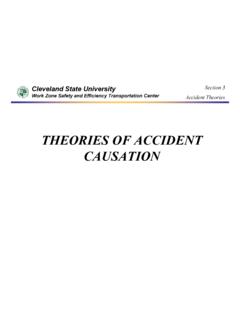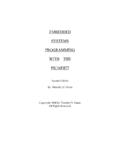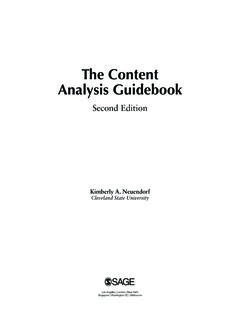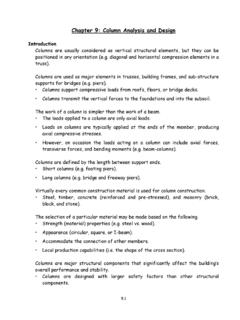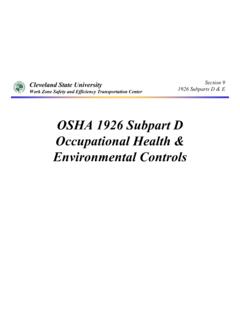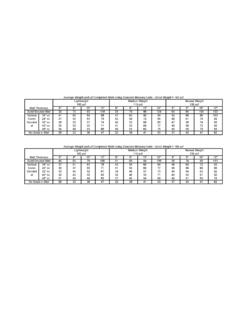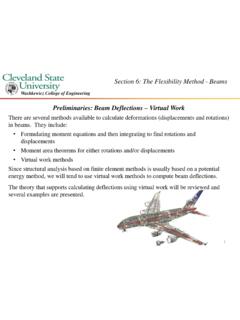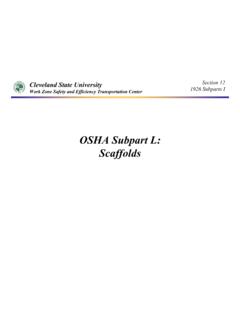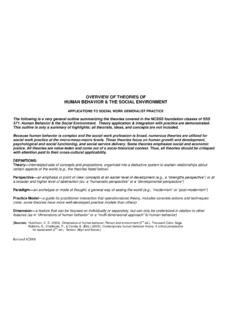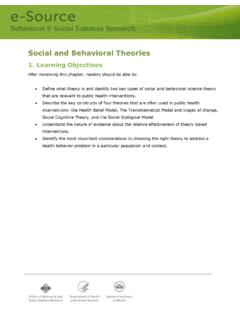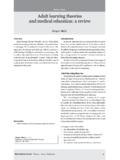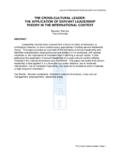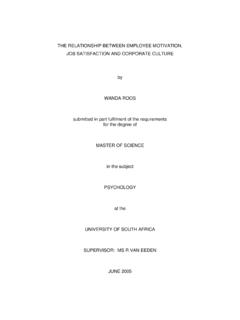Transcription of THEORIES OF ACCIDENT CAUSATION - …
1 Cleveland State UniversityWork Zone Safety and Efficiency Transportation CenterSection 3 ACCIDENT TheoriesTHEORIES OF ACCIDENT CAUSATION You ve carefully thought out all the angles. You ve done it a thousand times. It comes naturally to you. You know what you re doing, it s what you ve been trained to do your whole life. Nothing could possibly go wrong, right? Cleveland State University Work Zone Safety and Efficiency Transportation CenterSection 3 ACCIDENT THEORIES Cleveland State University Work Zone Safety and Efficiency Transportation CenterSection 3 ACCIDENT TheoriesCleveland State UniversityWork Zone Safety and Efficiency Transportation CenterSection 3 ACCIDENT TheoriesTheories of ACCIDENT CausationThere are several major THEORIES concerning ACCIDENT CAUSATION , each of which has some explanatory and predictive value. 1. The domino theory developed by H. W. Heinrich, a safety engineerand pioneer in the field of industrial ACCIDENT Human Factors Theory3.
2 ACCIDENT /Incident Theory4. Epidemiological Theory5. Systems Theory6. The energy release theory, developed by Dr. William Haddon, Jr.,of the Insurance Institute for Highway Behavior TheoryAccident THEORIES guide safety investigations. They describe the scope of an 's Domino TheoryAccording to Heinrich, an " ACCIDENT " is one factor in a sequence that may lead to an injury. The factors can be visualized as a series of dominoes standing on edge; when one falls, the linkage required for a chain reaction is completed. Each of the factors is dependent on the preceding factor. Cleveland State University Work Zone Safety and Efficiency Transportation CenterSection 3 ACCIDENT THEORIES Cleveland State University Work Zone Safety and Efficiency Transportation CenterSection 3 ACCIDENT TheoriesSocial Environmentand Inherited Behavior ( , alcoholism)Fault of the person (carelessness, bad temper, recklessness, etc)Unsafe act or condition Performing a task without the appropriate PPEA ccidentInjury outcome of some accidents but not all MISTAKES OF PEOPLE1932 First Scientific Approach to ACCIDENT /Prevention - HeinrichHeinrich s Dominos The personal injury (the final domino)
3 Occurs only as a result of an ACCIDENT occurs only as a result of a personal or mechanical and mechanical hazards exist only through the fault of careless persons or poorly designed or improperly maintained of persons are inherited or acquired as a result of their social environment or acquired by environment is where and how a person was raised and Cleveland State University Work Zone Safety and Efficiency Transportation CenterSection 3 ACCIDENT TheoriesHeinrich s Domino Theory Critical Issues The factor preceding the ACCIDENT (the unsafe act or the mechanical or physical hazard) and it should receive the most attention. Heinrich felt that the person responsible at a company for loss control should be interested in all five factors, but be concerned primarily with accidents and the proximate causes of those accidents. Heinrich also emphasized that accidents, not injuries or property damage, should be the point of attack.
4 An ACCIDENT is any unplanned, uncontrolled event that couldresult in personal injury or property damage. For example, if a person slips and falls, an injury may or may not result, but an ACCIDENT has taken place. Cleveland State University Work Zone Safety and Efficiency Transportation CenterSection 3 ACCIDENT TheoriesCleveland State UniversityWork Zone Safety and Efficiency Transportation CenterSection 3 ACCIDENT TheoriesHeinrich s Domino Theory Corrective Action Sequence (The three E s) Engineering Control hazards through product design or process change Education Train workers regarding all facets of safety Impose on management that attention to safety pays off Enforcement Insure that internal and external rules, regulations, and standard operating procedures are followed by workers as well as State UniversityWork Zone Safety and Efficiency Transportation CenterSection 3 ACCIDENT TheoriesHUMAN FACTORS THEORYH einrich posed his model in terms of a single domino leading to an ACCIDENT .
5 The premise here is that human errors cause accidents. These errors are categorized broadly as: OVERLOAD- The work task is beyond the capability of the worker1. Includes physical and psychological factors2. Influenced by environmental factors, internal factors, and situational factors INAPPROPRIATE WORKER RESPONSE- To hazards and safety measures (worker s fault)- To incompatible work station (management, environment faults) INAPPROPRIATE ACTIVITIES- Lack of training and misjudgment of riskBut the structure of this theory is still a cause/effect THEORYE xtension of human factors theory. Here the following new elements are introduced: Ergonomic traps These are incompatible work stations, tools or expectations (management failure) Decision to err Unconscious or conscious (personal failure) Systems failure Management failure (policy, training, etc.) Cleveland State University Work Zone Safety and Efficiency Transportation CenterSection 3 ACCIDENT TheoriesEPIDEMIOLOGICAL THEORYE pidemiology This field studies relationship between environmental factors and disease Can be used to study causal factors in a relationshipTwo key components:1 Predisposition characteristics tendencies may predispose worker to certain actions2 Situational characteristics peer pressure, poor attitude, risk takingTogetherthese characteristics can cause or prevent accidents that a person predisposed to a given situation or condition may succumb to.
6 Cleveland State University Work Zone Safety and Efficiency Transportation CenterSection 3 ACCIDENT TheoriesSummary - Traditional Chain-of-Events ACCIDENT Causality Models Explain accidents in terms of multiple events, sequencedas a forward chain over time. Events linked together by direct relationships (ignore indirect relationships). Events almost always involve component failure, human error, or energy-related events. Causality models form the basis for most safety-engineering and reliability engineering analyses and/or designs. Cleveland State University Work Zone Safety and Efficiency Transportation CenterSection 3 ACCIDENT TheoriesLimitations of Event-Chain Causality Models Neglects social and organizational factors Does not adequately account for human error One cannot simply and effectively model human behavior by decomposing it into individual decisions and actions.
7 One cannot study human error in isolation from: physical and social context; value system in which behaviors takes place; and dynamic work process Neglects adaptation Major accidents involve systematic migration of organizational behavior to higher levels of risk. Cleveland State University Work Zone Safety and Efficiency Transportation CenterSection 3 ACCIDENT TheoriesReliability Engineering vs. System Safety Both arose after World War II Reliability engineering is often confused with system safety engineering, but they are different and sometimes even conflict Reliability engineering focuses on quantifying probabilities of failure. System safety analysis ( , fault tree analysis) focuses on eliminating and controlling hazards Considers interactions among components and not just component failures Includes non-technical aspects of systems Highly reliable systems may be unsafe and safe systems may not be reliable.
8 Cleveland State University Work Zone Safety and Efficiency Transportation CenterSection 3 ACCIDENT THEORIES Cleveland State University Work Zone Safety and Efficiency Transportation CenterSection 3 ACCIDENT TheoriesCivil Engineers are accustomed to these types of charts CPM diagram (aka a PERT chart). Cleveland State University Work Zone Safety and Efficiency Transportation CenterSection 3 ACCIDENT TheoriesUnder normal circumstances chances of an ACCIDENT is low. Rather than looking at the environment as being full of hazards and people prone to errors, system safety assumes harmony (steady state) exists between individuals and the work environment. Cleveland State University Work Zone Safety and Efficiency Transportation CenterSection 3 ACCIDENT TheoriesSystems Theory Applied to Transportation EngineeringRoad accidents are seen as failures of the whole traffic system (interaction between the three elements) rather than a failure of the infrastructureVehicle Cleveland State University Work Zone Safety and Efficiency Transportation CenterSection 3 ACCIDENT TheoriesWhat about weather conditions?
9 The driver is a victim this assumes the demands that the traffic system puts on the driver is too complex for the driver s limited capacity to process information. As a result of this assumption the system must be designed to be less complex, which preventserrors from occurring. The energy and barriers perspective : The system must also reducethe negative consequences of errors, , introduce safety margins that allows the driver to incur an error without being hurt too seriously. Cleveland State University Work Zone Safety and Efficiency Transportation CenterSection 3 ACCIDENT TheoriesHADDON S ENERGY RELEASE THEORYW illam Haddon a medical doctor and the adminstrator of NHTSA at one point in time, in 1966 helped to impose the following regulations for new cars: 1. Seat belts for all occupants 2. Energy-absorbing steering column 3. Penetration-resistant windshield 4. Dual braking systems 5.
10 Padded instrument panel 6. All measures correspond with the energy and barrier concept Cleveland State University Work Zone Safety and Efficiency Transportation CenterSection 3 ACCIDENT THEORIES The systems theory approach, in contrast to the energy release theory, treats the driver as a passiveresponder in his environment. The evidence is that he is in fact an activeparticipant, regulating his/her level of preferred risk Risk compensation/ behavioural adaptation: operators within a system may take advantage of safety measures in other ways than to increase safety Two basic forms of compensation to road safety measures: Increased speed Reduced attention Cleveland State University Work Zone Safety and Efficiency Transportation CenterSection 3 ACCIDENT THEORIES .. more efficient brakes on an automobile will not in themselves make driving the automobile any safer. Better brakes will reduce the absolute size of the minimum stopping zone, it is true, but the driver soon learns this new zone and.
